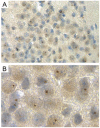Altered hypothalamus-pituitary-adrenal gland axis regulation in the expanded CGG-repeat mouse model for fragile X-associated tremor/ataxia syndrome
- PMID: 18472227
- PMCID: PMC4408208
- DOI: 10.1016/j.psyneuen.2008.03.011
Altered hypothalamus-pituitary-adrenal gland axis regulation in the expanded CGG-repeat mouse model for fragile X-associated tremor/ataxia syndrome
Abstract
The human FMR1 gene contains an unstable CGG-repeat in its 5' untranslated region. The repeat length in the normal population is polymorphic (5-54 CGG-repeats). Individuals carrying lengths beyond 200 CGGs (i.e. the full mutation) show hypermethylation and as a consequence gene silencing of the FMR1 gene. The absence of the gene product FMRP causes the fragile X syndrome, the most common inherited form of mental retardation. Elderly carriers of the premutation (PM), which is defined as a repeat length between 55 and 200 CGGs, can develop a progressive neurodegenerative syndrome: fragile X-associated tremor/ataxia syndrome (FXTAS). The high FMR1 mRNA levels observed in cells from PM carriers have led to the hypothesis that FXTAS is caused by a pathogenic RNA gain-of-function mechanism. Apart from tremor/ataxia, specific psychiatric symptoms have been described in PM carriers with or without FXTAS. Since these symptoms could arise from elevated stress hormone levels, we investigated hypothalamic-pituitary-adrenal (HPA) axis regulation using a knock-in mouse model with an expanded CGG-repeat in the PM range (>98 repeats) in the Fmr1 gene, which shows repeat instability, and displays biochemical, phenotypic and neuropathological characteristics of FXTAS. We show elevated levels of corticosterone in serum and ubiquitin-positive inclusions in both the pituitary and adrenal gland of 100-week-old animals. In addition, we demonstrate ubiquitin-positive inclusions in the amygdala from aged expanded CGG-repeat mice. We hypothesize that altered regulation of the HPA axis and the amygdala and higher stress hormone levels in the mouse model for FXTAS may explain associated psychological symptoms in humans.
Figures





Similar articles
-
Elevated Fmr1 mRNA levels and reduced protein expression in a mouse model with an unmethylated Fragile X full mutation.Exp Cell Res. 2007 Jan 15;313(2):244-53. doi: 10.1016/j.yexcr.2006.10.002. Epub 2006 Oct 13. Exp Cell Res. 2007. PMID: 17150213 Free PMC article.
-
Presence of inclusions positive for polyglycine containing protein, FMRpolyG, indicates that repeat-associated non-AUG translation plays a role in fragile X-associated primary ovarian insufficiency.Hum Reprod. 2016 Jan;31(1):158-68. doi: 10.1093/humrep/dev280. Epub 2015 Nov 3. Hum Reprod. 2016. PMID: 26537920 Free PMC article.
-
CGG-repeat length and neuropathological and molecular correlates in a mouse model for fragile X-associated tremor/ataxia syndrome.J Neurochem. 2008 Dec;107(6):1671-82. doi: 10.1111/j.1471-4159.2008.05747.x. Epub 2008 Nov 10. J Neurochem. 2008. PMID: 19014369 Free PMC article.
-
The FMR1 gene and fragile X-associated tremor/ataxia syndrome.Am J Med Genet B Neuropsychiatr Genet. 2009 Sep 5;150B(6):782-98. doi: 10.1002/ajmg.b.30910. Am J Med Genet B Neuropsychiatr Genet. 2009. PMID: 19105204 Free PMC article. Review.
-
CGG repeat in the FMR1 gene: size matters.Clin Genet. 2011 Sep;80(3):214-25. doi: 10.1111/j.1399-0004.2011.01723.x. Epub 2011 Jun 30. Clin Genet. 2011. PMID: 21651511 Free PMC article. Review.
Cited by
-
Enhanced asynchronous Ca(2+) oscillations associated with impaired glutamate transport in cortical astrocytes expressing Fmr1 gene premutation expansion.J Biol Chem. 2013 May 10;288(19):13831-41. doi: 10.1074/jbc.M112.441055. Epub 2013 Apr 3. J Biol Chem. 2013. PMID: 23553633 Free PMC article.
-
Motor deficits on a ladder rung task in male and female adolescent and adult CGG knock-in mice.Behav Brain Res. 2011 Sep 12;222(1):117-21. doi: 10.1016/j.bbr.2011.03.039. Epub 2011 Mar 31. Behav Brain Res. 2011. PMID: 21440572 Free PMC article.
-
Murine hippocampal neurons expressing Fmr1 gene premutations show early developmental deficits and late degeneration.Hum Mol Genet. 2010 Jan 1;19(1):196-208. doi: 10.1093/hmg/ddp479. Hum Mol Genet. 2010. PMID: 19846466 Free PMC article.
-
Clustered burst firing in FMR1 premutation hippocampal neurons: amelioration with allopregnanolone.Hum Mol Genet. 2012 Jul 1;21(13):2923-35. doi: 10.1093/hmg/dds118. Epub 2012 Mar 30. Hum Mol Genet. 2012. PMID: 22466801 Free PMC article.
-
Progressive spatial processing deficits in a mouse model of the fragile X premutation.Behav Neurosci. 2009 Dec;123(6):1315-24. doi: 10.1037/a0017616. Behav Neurosci. 2009. PMID: 20001115 Free PMC article.
References
-
- Aguilera G. Factors controlling steroid biosynthesis in the zona glomerulosa of the adrenal. J. Steroid. Biochem. Mol. Biol. 1993;45:147–151. - PubMed
-
- Aguilera G. Regulation of Pituitary ACTH Secretion during Chronic Stress. Frontiers in Neuroendocrinology. 1994;15:321–350. - PubMed
-
- Bacalman S, Farzin F, Bourgeois JA, Cogswell J, Goodlin-Jones BL, Gane LW, Grigsby J, Leehey MA, Tassone F, Hagerman RJ. Psychiatric Phenotype of the Fragile X-Associated Tremor/Ataxia Syndrome (FXTAS) in Males: Newly Described Fronto-Subcortical Dementia. J. Clin. Psychiatry. 2006;67:87–94. - PubMed
-
- Bakker CE, de Diego Otero Y, Bontekoe C, Raghoe P, Luteijn T, Hoogeveen AT, Oostra BA, Willemsen R. Immunocytochemical and biochemical characterization of FMRP, FXR1P, and FXR2P in the mouse. Exp. Cell. Res. 2000;258:162–170. - PubMed
-
- Bontekoe CJ, Bakker CE, Nieuwenhuizen IM, van Der Linde H, Lans H, de Lange D, Hirst MC, Oostra BA. Instability of a (CGG)(98) repeat in the Fmr1 promoter. Hum. Mol. Genet. 2001;10:1693–1699. - PubMed
Publication types
MeSH terms
Substances
Grants and funding
LinkOut - more resources
Full Text Sources
Other Literature Sources
Medical
Molecular Biology Databases
Miscellaneous

